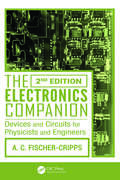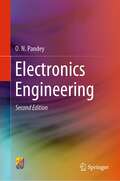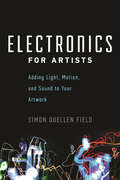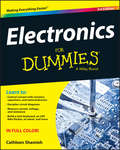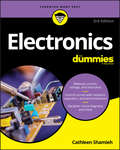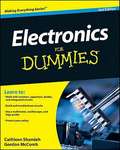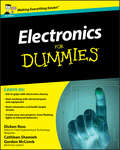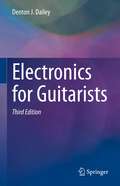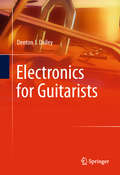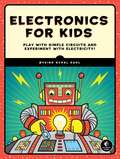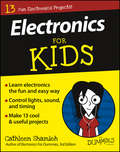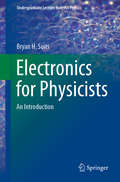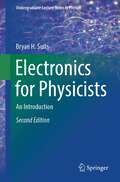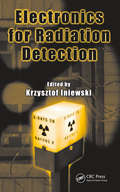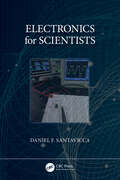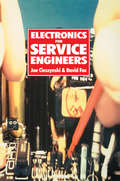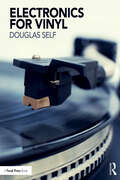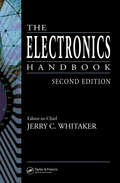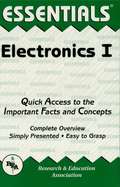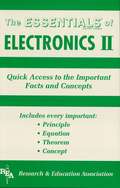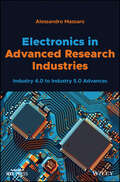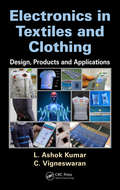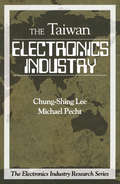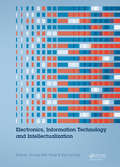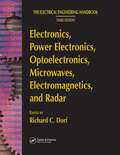- Table View
- List View
The Electronics Companion: Devices and Circuits for Physicists and Engineers, 2nd Edition
by Anthony C. Fischer-CrippsUnderstand Introductory Electronics Updated and expanded with new topics, The Electronics Companion: Devices and Circuits for Physicists and Engineers, 2nd Edition presents a full course in introductory electronics using a unique and educational presentation technique that is the signature style of the author's companion books. This concise yet det
Electronics Engineering
by O. N. PandeyThis book is primarily designed to serve as a textbook for undergraduate students of electrical, electronics, and computer engineering, but can also be used for primer courses across other disciplines of engineering and related sciences. The first edition of this book was published in 2015. The book has been completely revised and a chapter on PSPICE has also been included. The book covers all the fundamentals aspects of electronics engineering, from electronic materials to devices, and then to basic electronic circuits. The topics covered are the basics of electronics, semiconductor diodes, bipolar junction transistors, field-effect transistors, operational amplifiers, switching theory and logic design, electronic instruments, and Pspice. The book is written in a simple narrative style that makes it easy to understand for the first year students. It includes a lot of illustrative diagrams and examples, to enable students to practice. Each chapter contains a summary followed by questions asked during the University examinations to enable students to practice before the final examination. The contents of this book will be useful also for students and enthusiasts interested in learning about basic electronics without the benefit of formal coursework.
Electronics for Artists: Adding Light, Motion, and Sound to Your Artwork
by Simon Quellen FieldWith today's modern technology--LEDs, servomotors, motion sensors, speakers, and more--artwork can incorporate elements of light, sound, and motion for dramatic effects. Author and educator Simon Quellen Field has developed a primer for creative individuals looking for new ways to express themselves though electronically enhanced art. Following step-by-step examples of basic circuitry and programming, readers can develop the skills necessary to enhance their works of art. The book also features art projects to try, including a bouquet of glowing flowers, an LED metronome, a talking computer, a sensile robot, and a simple wheeled robot. A variety of artistic works created by Field's students and based on these open-ended lessons are also included to provide creative sparks for the readers. For those interested in programming their circuits, Field explores the basics of Energia, a free software package, and provides simple programs to create flashing light patterns, computer controlled motors, and LCD text displays.
Electronics For Dummies
by Cathleen ShamiehExplore the basic concepts of electronics, build your electronics workbench, and begin creating fun electronics projects right away! Electronics For Dummies, 3rd Edition is Packed with hundreds of colorful diagrams and photographs, this book provides step-by-step instructions for experiments that show you how electronic components work, advice on choosing and using essential tools, and exciting projects you can build in 30 minutes or less. You'll get charged up as you transform theory into action in chapter after chapter! * Circuit basics -- learn what voltage is, where current flows (and doesn't flow), and how power is used in a circuit* Critical components -- discover how resistors, capacitors, inductors, diodes, and transistors control and shape electric current* Versatile chips -- find out how to use analog and digital integrated circuits to build complex projects with just a few parts* Analyze circuits -- understand the rules that govern current and voltage and learn how to apply them* Safety tips -- get a thorough grounding in how to protect yourself--and your electronics--from harm Electronics For Dummies, 3rd Edition helps you explore the basic concepts of electronics with confidence -- this book will get you charged up!
Electronics For Dummies (For Kids For Dummies Ser.)
by Cathleen ShamiehBuild your electronics workbench—and begin creating fun electronics projects right away Packed with hundreds of colorful diagrams and photographs, this book provides step-by-step instructions for experiments that show you how electronic components work, advice on choosing and using essential tools, and exciting projects you can build in 30 minutes or less. You'll get charged up as you transform theory into action in chapter after chapter! Circuit basics — learn what voltage is, where current flows (and doesn't flow), and how power is used in a circuit Critical components — discover how resistors, capacitors, inductors, diodes, and transistors control and shape electric current Versatile chips — find out how to use analog and digital integrated circuits to build complex projects with just a few parts Analyze circuits — understand the rules that govern current and voltage and learn how to apply them Safety tips — get a thorough grounding in how to protect yourself—and your electronics—from harm Electronics For Dummies (9781119675594) was previously published as Electronics For Dummies (9781119117971). While this version features a new Dummies cover and design, the content is the same as the prior release and should not be considered a new or updated product.
Electronics For Dummies
by Cathleen Shamieh Gordon MccombElectronics is fascinating - want to make something of it? This book shows you how! You can make all sorts of things, once you understand what electronics is and how it works. This book helps you out with that part, explaining the whole thing in plain English. Learn how electricity functions, how to harness it and put it to work, what tools you need to build circuits, what you can make with them, and how to do it safely. Mystery solved - understand what makes your iPod, remote control, and computer work Essential stuff - outfit your electronics lab with all the necessary tools, including some that will surprise you Schematic road maps - learn to read schematics and understand how they help your project get where it's going Symbols of power - recognize all the identifiers for power sources, grounds, and components Tools of the trade - discover how to use a multimeter, logic probe, oscilloscope, and solderless breadboard Break it down - get to know the ins and outs of components such as resistors, capacitors ,diodes and transistors Getting it together - find out how integrated circuits make all the rest possible and learn to work with them & Analyze it - understand the rules that govern current and voltage and learn how to apply them Open the book and find: The difference between electronics and electricity A list of essential tools Cool projects you can build quickly Great places to find parts Important safety tips What a sine wave is Interesting stuff about speakers, buzzers, and DC motors Ohm's Law and how to use it
Electronics For Dummies
by Cathleen Shamieh Dickon Ross Gordon MccombDo you dream of wiring up a flashing LED, experimenting with infrared detectors, or building a walking-talking robot from scratch? Do you want to understand what capacitors, oscilloscopes and transistors actually do? Then look no further!Electronics For Dummies, UK Editioncovers everything from understanding the technology behind day-to-day gadgets, to reading a schematic, getting to grips with multimeters, and devising projects that are both useful and fun. With UK-specific information on where to purchase components for your workbench and the most useful websites and resources, this essential guide will get you up, running, and switched on in no time. Electronics For Dummies, UK Edition includes:Part I: Understanding The Fundamentals of ElectronicsChapter 1: What is Electronics and What Can It Do For You?Chapter 2: Moving Electrons to Make Something HappenChapter 3: Meeting Up with ResistanceChapter 4: Getting a Charge Out of CapacitorsChapter 5: Curling Up With Coils and CrystalsChapter 6: The Wide World of SemiconductorsChapter 7: Packing Parts Together on Integrated CircuitsChapter 8: Rounding Out Your Parts ListPart II: Getting Your Hands DirtyChapter 9: Setting Up Shop and Ensuring Your SafetyChapter 10: Reading SchematicsChapter 11: Constructing CircuitsChapter 12: Measuring and Analysing CircuitsPart III: Putting Theory Into PracticeChapter 13: Exploring Some Learning CircuitsChapter 14: Great Projects You Can Build in 30 Minutes or LessChapter 15: Cool Robot Projects to Amaze Your Friends and FamilyPart IV: The Part of TensChapter 16: Ten (Or So) Terrific Tips to Help You SucceedChapter 17: Ten Great Electronics Parts SourcesChapter 18: Ten Electronics Formulas You Should KnowAppendix: Internet ResourcesGetting Up to Speed with Tutorials and General InformationFiguring Things Out with CalculatorsSurfing for CircuitsAsking Questions in Discussion ForumsGetting Things Surplus
Electronics for Guitarists
by Denton J. DaileyThis updated, augmented third edition is aimed at hobbyists, students, engineers, and others who would like to learn more about the design and operation of electronic circuits used by guitarists. This book presents accessible qualitative and quantitative descriptions and analysis of a wide range of popular amplifier and effects circuits, along with basic design techniques allowing the reader to design their own circuits. The new edition further includes several additional circuits and topics suggested by readers of the previous editions, including noise gates, analog multipliers, the effects loop, and additional tube amplifier design examples.
Electronics for Guitarists
by Denton J. DaileyThis book is written for the guitarist that would like to know how transistor and vacuum tube-based amplifiers, and how various circuits effects work. The main thrust of the material is old school analog circuitry, including heavy coverage of discrete transistors and diodes, classical filter circuits, and vacuum tube-based amplifiers. This book should be useful to electronics hobbyists, technologists and engineers that are interested in guitar-related applications.
Electronics for Kids: Play with Simple Circuits and Experiment with Electricity!
by Oyvind Nydal Dahl<P>Why do the lights in a house turn on when you flip a switch? How does a remote-controlled car move? And what makes lights on TVs and microwaves blink? The technology around you may seem like magic, but most of it wouldn’t run without electricity.Electronics for Kids demystifies electricity with a collection of awesome hands-on projects. <P>In Part 1, you’ll learn how current, voltage, and circuits work by making a battery out of a lemon, turning a metal bolt into an electromagnet, and transforming a paper cup and some magnets into a spinning motor. <P> In Part 2, you’ll make even more cool stuff as you: <br>–Solder a blinking LED circuit with resistors, capacitors, and relays <br>–Turn a circuit into a touch sensor using your finger as a resistor–Build an alarm clock triggered by the sunrise <br>–Create a musical instrument that makes sci-fi sounds. <P>Then, in Part 3, you’ll learn about digital electronics—things like logic gates and memory circuits—as you make a secret code checker and an electronic coin flipper. Finally, you’ll use everything you’ve learned to make the LED Reaction Game—test your reaction time as you try to catch a blinking light!With its clear explanations and assortment of hands-on projects, Electronics for Kids will have you building your own circuits in no time.
Electronics For Kids For Dummies
by Cathleen ShamiehThe easy way for kids to get started with electronics If your youngster likes to tinker, Electronics For Kids For Dummies is here to teach them the core concepts of electronics in a fun and engaging way. Written in a language elementary-to-middle-school-aged kids can understand, it's packed with full-color photos, easy-to-follow instructions, simple examples, and 13 cool projects that will boost your child's confidence while instilling valuable electronics lessons. Written by an experienced engineer who authored Electronics For Dummies, this friendly guide shows children the right way to learn about this exciting--but potentially dangerous--field. From making their very own LED flashlight and basic radio to building a smart nightlight and making an LED blink, Electronics For Kids For Dummies walks young readers through 13 projects that are easy to accomplish--and, most importantly, fun! Plus, the full-color design is heavy on eye-catching graphics and the format is focused on the steps to completing a project, making it approachable for any youngster with an interest in exploring the electrifying world of electronics. Introduces kids to the basics of electronics Includes 13 projects that promote your kid's sense of achievement Features larger print to make the material less intimidating and easier to navigate Covers tools and safety measures to ensure your child's safety Spark your child's interest in the shockingly exciting field of electronics with Electronics For Kids For Dummies!
Electronics for Physicists: An Introduction (Undergraduate Lecture Notes in Physics)
by Bryan H. SuitsThis book provides undergraduate physics majors and students of related sciences with a sound basic understanding of electronics and how it is used, principally in the physical sciences. While today few science students go on to careers that demand an ability to design and build electronic circuits, many will use and rely on electronics. As scientists, they will require an appropriate level of fundamental knowledge that enables them, for example, to understand what electronic equipment is doing, to correctly interpret the measurements obtained, and to appreciate the numerous links between electronics and how it is practiced, and other areas of science. Discussing electronics in the broader context and from the point of view of the scientist, this book is intended for students who are not planning to become electronics specialists. It has been written in a relatively informal, personal style and includes detailed examples, as well as some “outside the box” material to inspire thought and creativity. A selection of relevant exercises is included at the end of each chapter.
Electronics for Physicists: An Introduction (Undergraduate Lecture Notes in Physics)
by Bryan H. SuitsThis book provides undergraduate physics majors and students of related sciences with a sound understanding of basic electronics and how it is used in the physical sciences. While today few science students go on to careers that demand an ability to design and build electronic circuits, many will use and rely on electronics. As scientists, they will require an appropriate level of fundamental knowledge that enables them, for example, to understand what electronic equipment is doing, to correctly interpret the measurements obtained, and to appreciate the numerous links between electronics and how it is practiced and other areas of science. Discussing electronics in the broader context and from the point of view of the scientist, this book is intended for students who are not planning to become electronics specialists but who will use electronics. It has been written in a relatively informal style and includes many detailed examples, as well as some “outside the box” material, including some ideas from quantum computing, to inspire thought and creativity. A selection of relevant exercises is included at the end of each chapter.In the updated second edition, some sections are clarified and end-of-chapter problems are added. It includes an additional chapter on quantum logic/computing
Electronics for Radiation Detection (Devices, Circuits, and Systems)
by Krzysztof IniewskiThere is a growing need to understand and combat potential radiation damage problems in semiconductor devices and circuits. Assessing the billion-dollar market for detection equipment in the context of medical imaging using ionizing radiation, Electronics for Radiation Detection presents valuable information that will help integrated circuit (IC) designers and other electronics professionals take full advantage of the tremendous developments and opportunities associated with this burgeoning field. Assembling contributions from industrial and academic experts, this book— Addresses the state of the art in the design of semiconductor detectors, integrated circuits, and other electronics used in radiation detection Analyzes the main effects of radiation in semiconductor devices and circuits, paying special attention to degradation observed in MOS devices and circuits when they are irradiated Explains how circuits are built to deal with radiation, focusing on practical information about how they are being used, rather than mathematical details Radiation detection is critical in space applications, nuclear physics, semiconductor processing, and medical imaging, as well as security, drug development, and modern silicon processing techniques. The authors discuss new opportunities in these fields and address emerging detector technologies, circuit design techniques, new materials, and innovative system approaches. Aimed at postgraduate researchers and practicing engineers, this book is a must for those serious about improving their understanding of electronics used in radiation detection. The information presented here can help you make optimal use of electronic detection equipment and stimulate further interest in its development, use, and benefits.
Electronics for Scientists
by Daniel F. SantaviccaElectronics for Scientists provides a practical and concise introduction to electrical circuits, signals, and instrumentation for undergraduate students in the physical sciences. No previous familiarity with electronics is required and concepts are grounded in the relevant physics. The book aims to give students the electronics background needed to be successful in experimental science. The book begins with the fundamentals of DC circuits. This is followed by AC circuits and their analysis using the concept of impedance. The transfer function is introduced and used to analyze different types of filter circuits. The conversion between time-domain and frequency-domain signal representations is reviewed. Transmission lines are introduced and used to motivate the different approach to designing microwave-frequency circuits as compared to lower-frequency circuits. The physics of semiconductors is reviewed and used to understand the behavior of diodes and transistors, and a number of diode and transistor circuits is analyzed. The operational amplifier (op-amp) is introduced and several op-amp circuits are analyzed. Techniques for quantifying noise in electrical measurements are described and common sources of noise are discussed. The last major topic is digital circuits, which include analog-to-digital conversion, logic gates, and digital memory circuits. The book concludes with a brief introduction to quantum computing. Designed for a one-semester course, this book brings together a range of topics relevant to experimental science that are not commonly found in a single text. Worked examples are provided throughout the book, and each chapter concludes with a set of problems to reinforce the material covered. The subject of electronics is indispensable to a wide array of scientific and technical fields, and this book seeks to provide an approachable point of access to this rich and important subject.
Electronics for Service Engineers
by Dave FoxElectronics for Service Engineers is the first text designed specifically for the Level 2 NVQs in Electronics Servicing. It provides the underpinning knowledge required by brown goods and white goods students, reflecting the popularity of the EMTA white goods NVQs. It has also been written in the light of the new EEB / City & Guilds Level 2 progression award (RVQ) for brown goods and commercial electronics, dubbed 'son of 2240', and the existing 2240 part 1. The wide ranging experience of the authors makes this a readable book with much relevance to the real-life challenges of the service engineer. From simple mathematics and circuit theory to transmission theory and aerials, from health and safety to logic gates and transducers, the complete range of knowledge required to service electronic and electrical equipment is here. This practical emphasis makes the book ideal for existing service engineers seeking to gain an NVQ. Numerous questions and worked examples throughout the text allow readers to monitor their own progress, and provide practice for C&G tests.Joe Cieszynski and Dave Fox have a wide mix of experience, both in the field and workshop working on TV and audio, and teaching electronic servicing and security installation at MANCAT. Joe writes regularly for Television magazine.
Electronics for Vinyl
by Douglas SelfElectronics for Vinyl is the most comprehensive book ever produced on the electronic circuitry needed to extract the best possible signal from grooves in vinyl. What is called the "vinyl revival" is in full swing, and a clear and comprehensive account of the electronics you need is very timely. Vinyl reproduction presents some unique technical challenges; the signal levels from moving-magnet cartridges are low, and those from moving-coil cartridges lower still, so a good deal of high-quality low-noise amplification is required. Some of the features of Electronics for Vinyl include: integrating phono amplifiers into a complete preamplifier; differing phono amplifier technologies; covering active, passive, and semi-passive RIAA equalisation and transconductance RIAA stages; the tricky business of getting really accurate RIAA equalisation without spending a fortune on expensive components, such as switched-gain MM/MC RIAA amplifiers that retain great accuracy at all gains, the effects of finite open-loop gain, cartridge-preamplifier interaction, and so on; noise and distortion in phono amplifiers, covering BJTs, FETs, and opamps as input devices, hybrid phono amplifiers, noise in balanced MM inputs, noise weighting, and cartridge load synthesis for ultimately low noise; archival and non-standard equalisation for 78s etc.; building phono amplifiers with discrete transistors; subsonic filtering, covering all-pole filters, elliptical filters, and suppression of subsonics by low-frequency crossfeed, including the unique Devinyliser concept; ultrasonic and scratch filtering, including a variety of variable-slope scratch filters; line output technology, including zero-impedance outputs, on level indication for optimal setup, and on specialised power supplies; and description of six practical projects which range from the simple to the highly sophisticated, but all give exceptional performance. Electronics for Vinyl brings the welcome news that there is simply no need to spend huge sums of money to get performance that is within a hair’s breadth of the best theoretically obtainable. But you do need some specialised knowledge, and here it is.
The Electronics Handbook (ISSN)
by Jerry C. WhitakerDuring the ten years since the appearance of the groundbreaking, bestselling first edition of The Electronics Handbook, the field has grown and changed tremendously. With a focus on fundamental theory and practical applications, the first edition guided novice and veteran engineers along the cutting edge in the design, production, installation, operation, and maintenance of electronic devices and systems. Completely updated and expanded to reflect recent advances, this second edition continues the tradition.The Electronics Handbook, Second Edition provides a comprehensive reference to the key concepts, models, and equations necessary to analyze, design, and predict the behavior of complex electrical devices, circuits, instruments, and systems. With 23 sections that encompass the entire electronics field, from classical devices and circuits to emerging technologies and applications, The Electronics Handbook, Second Edition not only covers the engineering aspects, but also includes sections on reliability, safety, and engineering management. The book features an individual table of contents at the beginning of each chapter, which enables engineers from industry, government, and academia to navigate easily to the vital information they need. This is truly the most comprehensive, easy-to-use reference on electronics available.
Electronics I Essentials
by The Editors of REAREA's Essentials provide quick and easy access to critical information in a variety of different fields, ranging from the most basic to the most advanced. As its name implies, these concise, comprehensive study guides summarize the essentials of the field covered. Essentials are helpful when preparing for exams, doing homework and will remain a lasting reference source for students, teachers, and professionals. Electronics I covers fundamentals of semiconductor devices, junction diodes, bipolar junction transistors, power supplies, multitransistor circuits, small signals, low-frequency analysis and design, audio-frequency linear power amplifiers, feedback amplifiers, and frequency response of amplifiers.
Electronics II Essentials
by The Editors of REAREA's Essentials provide quick and easy access to critical information in a variety of different fields, ranging from the most basic to the most advanced. As its name implies, these concise, comprehensive study guides summarize the essentials of the field covered. Essentials are helpful when preparing for exams, doing homework and will remain a lasting reference source for students, teachers, and professionals. Electronics II covers operational amplifiers, feedback and frequency compensation of OP amps, multivibrators, logic gates and families, Boolean algebra, registers, counters, arithmetic units, oscillators, radio-frequency circuits, flip-flops, and waveshaping and waveform generators.
Electronics in Advanced Research Industries: Industry 4.0 to Industry 5.0 Advances
by Alessandro MassaroA one-of-a-kind examination of the latest developments in machine control In Electronics in Advanced Research Industries: Industry 4.0 to Industry 5.0 Advances, accomplished electronics researcher and engineer Alessandro Massaro delivers a comprehensive exploration of the latest ways in which people have achieved machine control, including automated vision technologies, advanced electronic and micro-nano sensors, advanced robotics, and more. The book is composed of nine chapters, each containing examples and diagrams designed to assist the reader in applying the concepts discussed within to common issues and problems in the real-world. Combining electronics and mechatronics to show how they can each be implemented in production line systems, the book presents insightful new ways to use artificial intelligence in production line machines. The author explains how facilities can upgrade their systems to an Industry 5.0 environment. Electronics in Advanced Research Industries: Industry 4.0 to Industry 5.0 Advances also provides: A thorough introduction to the state-of-the-art in a variety of technological areas, including flexible technologies, scientific approaches, and intelligent automatic systems Comprehensive explorations of information technology infrastructures that support Industry 5.0 facilities, including production process simulation Practical discussions of human-machine interfaces, including mechatronic machine interface architectures integrating sensor systems and machine-to-machine (M2M) interfaces In-depth examinations of internet of things (IoT) solutions in industry, including cloud computing IoT Perfect for professionals working in electrical industry sectors in manufacturing, production line manufacturers, engineers, and members of R&D industry teams, Electronics in Advanced Research Industries: Industry 4.0 to Industry 5.0 Advances will also earn a place in libraries of technicians working in the process industry.
Electronics in Textiles and Clothing: Design, Products and Applications
by L. Ashok Kumar C. VigneswaranThis book covers the basic fundamentals of electronics and their applications in textiles and clothing product development. With increasing awareness about the e-textiles, researchers and scientists are finding ways to treat the textile materials integrating with electronics for communication/signal transferring applications. The book discusses wearable electronics, fabric production techniques for wearable electronics, design of circuits and integration into wearable electronic fabrics, product development, software development, design and development of wearable electronic flexible solar tent, and garment integrated wearable electronic products.
Electronics Industry in Taiwan
by Chung-Shing Lee Michael PechtTaiwan's electronics industry, especially the semiconductor and information products sectors, is characterized by rapid growth and high potential. This book investigates the past performance, current status, and future development of this industry, providing engineers with important data. Corporate business planners and electronics managers will find helpful information for decision making regarding joint ventures and alliances with Taiwanese manufacturers.
Electronics, Information Technology and Intellectualization: Proceedings of the International Conference EITI 2014, Shenzhen, China, 16-17 August 2014
by Young Min Song Kyung Sup KwakThe International Conference on Electronics, Information Technology and Intellectualization (ICEITI2014) was dedicated to build a high-level international academic communication forum for international experts and scholars. This fi rst conference of an annual series was held in Pengcheng, Shenzhen, China 16-17 August 2014. Many prestigious experts
Electronics, Power Electronics, Optoelectronics, Microwaves, Electromagnetics, and Radar (The Electrical Engineering Handbook)
by Richard C. DorfIn two editions spanning more than a decade, The Electrical Engineering Handbook stands as the definitive reference to the multidisciplinary field of electrical engineering. Our knowledge continues to grow, and so does the Handbook. For the third edition, it has expanded into a set of six books carefully focused on a specialized area or field of study. Electronics, Power Electronics, Optoelectronics, Microwaves, Electromagnetics, and Radar represents a concise yet definitive collection of key concepts, models, and equations in these areas, thoughtfully gathered for convenient access. Electronics, Power Electronics, Optoelectronics, Microwaves, Electromagnetics, and Radar delves into the fields of electronics, integrated circuits, power electronics, optoelectronics, electromagnetics, light waves, and radar, supplying all of the basic information required for a deep understanding of each area. It also devotes a section to electrical effects and devices and explores the emerging fields of microlithography and power electronics. Articles include defining terms, references, and sources of further information. Encompassing the work of the world’s foremost experts in their respective specialties, Electronics, Power Electronics, Optoelectronics, Microwaves, Electromagnetics, and Radar features the latest developments, the broadest scope of coverage, and new material in emerging areas.
